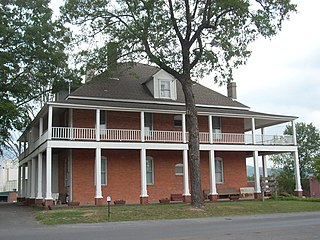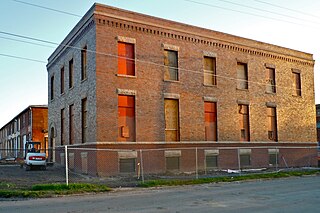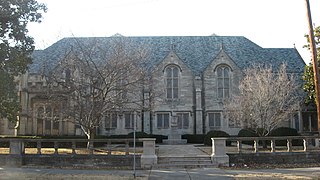This is a list of properties and historic districts in Tennessee that are listed on the National Register of Historic Places. There are over 2,000 in total. Of these, 29 are National Historic Landmarks. Each of Tennessee's 95 counties has at least one listing.

Christ Episcopal Church is an Episcopal congregation in South Pittsburg, Tennessee, part of the Episcopal Diocese of East Tennessee. The church building and parish house, located at 302 West 3rd Street, are listed on the National Register of Historic Places.

The old Roane County Courthouse building in Kingston, Tennessee, the county seat of Roane County. Built in the 1850s, it is one of six remaining antebellum county courthouses in the state of Tennessee.
This is a list of the National Register of Historic Places listings in Hamilton County, Tennessee.

The Bristol Commercial Historic District is a national historic district in Bristol, Tennessee and Bristol, Virginia.

Edison Storage Battery Company Building, is located at 177 Main Street and Lakeside Avenue in West Orange, Essex County, New Jersey, United States. The building was added to the National Register of Historic Places on February 28, 1996.

The C. R. Joy House, also known as The Grande Anne Bed & Breakfast, was a historic building located in Keokuk, Iowa, United States. It was destroyed by fire in July 2018. It was individually listed on the National Register of Historic Places in 1997. In 2002 it was included as a contributing property in The Park Place-Grand Avenue Residential District.

The Wheeler–Schebler Carburetor Company was one of the Indianapolis's most important auto parts manufacturers and the last automobile parts factories in Indianapolis, Indiana to survive from the first decades of the 20th century. The Wheeler–Schebler Carburetor Company Building was the company's original building at the Barth Avenue site. It was added to the National Register of Historic Places in 2004.

The Groton Bridge Co. was an American construction company.

Wright Hotel is a historic hotel at 201 East Market Street in Chatsworth, in Murray County, Georgia, that was built in 1909. It is a two-story brick building with two-story porches. It was added to the National Register of Historic Places in 1982.

The Fly Manufacturing Company Building is a historic industrial building in Shelbyville, Tennessee, that now houses the Fly Arts Center, a cultural facility. It is listed on the National Register of Historic Places.

The Richland–West End Historic District is a historic district on the Western side of Nashville, Tennessee. It comprises approximately a 12-block area consisting mostly of Bungalow/craftsman architecture and about 70 Foursquare-style houses.

The Spaulding Manufacturing Company is a complex of historic buildings located in Grinnell, Iowa, United States. Vermont native H.W. Spaulding settled in Grinnell in 1876 to open a blacksmith and wagon repair shop. Not long after, he started to manufacture wagons. Because of his modest success he entered into a series of partnerships over the years. The oldest building in the complex was completed around 1880, and the company grew to a complex of five buildings. The last building was completed in 1910, and has a masonry chimney that originally rose to 110 feet (34 m) high. All the buildings are brick construction, and they range in height from two floors to three floors. As modes of transportation began to change, so did Spaulding. The company began manufacturing automobiles. They were one of several early automobile manufacturers that had existing operations that manufactured bicycles, wagons, and carriages. They went out of business in 1929. Since that time the facility has housed a variety of small-scale manufactures, and even a veterinary clinic. Part of the plant has been renovated and now houses the Iowa Transportation Museum. The complex was listed on the National Register of Historic Places in 1978.

Cantol Wax Company Building, also known as Oakes Manufacturing Company Building and Wylie's Furniture Warehouse, is a historic industrial / commercial building located at Bloomington, Monroe County, Indiana. It was built between about 1905 and 1907, and consists of a 3 1/2-story, rectangular, front section, and 2 1/2-story rear addition. The masonry building has a rubble limestone foundation, terra cotta block walls, and Classical Revival style design elements. It was originally constructed for the Oakes Manufacturing Company, then housed the Cantol Wax Company after 1920.

Woolery Stone Company is a historic limestone quarry and manufacturing complex located at Bloomington, Monroe County, Indiana. The property includes a variety of buildings, structures, and objects associated with the production of dimensional limestone. These include the limestone faced International Style headquarters building, metal mill office, machine shop, blacksmith shop, limestone storage structure, limestone walls, and the grand scale all metal mill building.

The Thomas W. Phillips Memorial is a historic building in Nashville, Tennessee, United States, owned by Vanderbilt University. It was home to the Disciples of Christ Historical Society until the building was purchased by Vanderbilt in 2015. It was built in 1956. It has been listed on the National Register of Historic Places since November 9, 2006.

The Boston Block, also known as Aalfs Manufacturing Company, is a historic building located in Sioux City, Iowa, United States. The city experienced a building boom that began in the late 1880s and continued into the early 1890s. One of the major players in that building boom was the Boston Investment Company, a company on the East Coast who built four large commercial blocks in Sioux City simultaneously. Construction on the four buildings began in 1890 and they were completed the following year. In addition to the commercial blocks, they also built a steam heating plant that provided steam and light to three of the buildings as well as to neighboring buildings. The Massachusetts Block on the southwest corner of Fourth and Jackson was six stories tall and had a similar facade as the Boston Block, which is five stories tall on the northeast corner of Fourth and Virginia. The Plymouth Block on the southeast corner of Fourth and Locust was also five stories tall, and the Bay State Block on Fourth Street is the shortest at four stories. Among the building's tenants was the Aalfs Manufacturing Company, which used the building as its headquarters.

The Dubuque Casket Company is a historic building located in Dubuque, Iowa, United States. The city was a leading national market in the production of caskets towards the end of the 19th century. This location had been the site of a casket manufacturing plant from 1877 to 1987. The Dubuque Furniture and Burial Case Company was the first firm in Dubuque and the first to locate here. The building was largely destroyed by fire in 1883 and the company was forced out of business. The Dubuque Casket Company was incorporated in 1893 and acquired this property. They started construction of the first part of this building the same year. The four-story brick Neoclassical building was one of the largest manufacturing facilities in Dubuque. The machine and equipment room was located on the first floor, they manufactured fine cloth covered caskets on the second floor, they manufactured undertaker's dry goods on the third floor, and the fourth floor was used for storage. The first addition, now known as the center section was begun in 1903, and another expansion that also unified the main facade was begun in 1911. Two other Dubuque casket manufacturers, Iowa Coffin Company and the Hawkeye Casket Company, were out of business by 1924.

The Kahn Tailoring Company building is a historic structure located in downtown Indianapolis, Indiana. It was designed by Indianapolis architects Vonnegut & Bohn and built in 1913. The building is a four-story Neoclassical style structure with reinforced concrete behind a brick veneer. The front entrance features a cornice with decorative features.

















